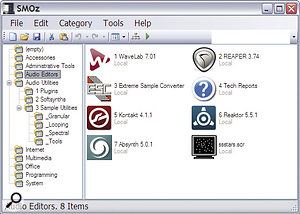Keep the creativity flowing and discover long‑lost plug‑ins with a properly organised Start menu.
Starting with Windows Vista, Microsoft made application launches easier by adding a search box to the Start menu that suggests the most likely candidates as you type in their name. This makes light work of launching apps whose names you know, even in part, but it's no help when you can't remember them at all, and — let's face it — there are lots of good plug‑ins, synths and audio utilities available from developers who are not household names, and whose products may not have memorable names either.
Hidden Gems
Even worse, most people's Start menu 'All Programs' content has already mushroomed into a vast and unwieldy scrolling list. I thought my PC was already well organised until, this month, I stumbled across a really handy audio utility that I'd installed years ago and completely forgotten about.
If you want to be able to find and launch all your audio applications more quickly, the secret is to organise the contents of your All Programs folder into suitably grouped categories. This will not alter any of the applications themselves; we are simply reorganising the shortcuts to them so that you can find the most suitable app for the task at hand.
Organised Sound
I've always created and maintained my Start menu folder organisation by hand using Windows Explorer, but while writing this column it occurred to me that someone must have developed an easier‑to‑use utility for the task. I downloaded and tried out quite a few, but ended up using the freeware SMOz (Start Menu Organizer, downloadable from http://smoz.sourceforge.net), which should run on Windows XP/Vista/7, and is quick and easy to use, once you get the hang of it. You just create new categories (or convert existing folders to categories), drag and drop your shortcuts as you will, and then apply the changes. Using the freeware Start Menu Organizer to organise your Start menu will streamline the finding and launching of all your audio applications, utilities and manuals, so you can get on with the more important task of being creative.
Using the freeware Start Menu Organizer to organise your Start menu will streamline the finding and launching of all your audio applications, utilities and manuals, so you can get on with the more important task of being creative.
In my case, I had already defined folders labelled 'Audio Editors' and 'Audio Utilities' (with sub‑folders labelled 'Softsynths' and 'Plugins'). However, so many smaller utilities had crept onto the Audio Utilities list that it had become long and unwieldy.
The solution, in my case, was to create a third category inside my existing Audio Utilities folder labelled 'Sample Utilities', into which I created further sub‑folders named 'Tools', 'Granular', 'Looping' and 'Spectral'. Now I know exactly where to look for particular tools, without having to worry about remembering the name of the developer, or even the tool itself!
Your folder names and sorting requirements will, of course, be different from mine, but the principles always remain the same: if the contents of any of your Start menu folders are too long to take in at a glance, split them into several smaller categories with meaningful names and move any rarely used items into deeper folders named 'Utilities' or 'Accessories', so they leave the main ones easier to navigate. When inspiration strikes, you want the creative process to be as smooth as possible!
Sandy Saga
After months of build‑up, the new second‑generation 'Sandy Bridge' Core i7 processor range is finally here, and what a frustrating situation for the musician! Offering huge potential improvements over its predecessors — and with a new socket and chip set to support them — initial reports showed excellent audio hardware/software performance for the price, particularly from the Core i7‑2600K model with four cores running at 3.4GHz. There was even more excitement when samples of this were easily over‑clocked to 4.4GHz! Intel's new Sandy Bridge Core i7 processors offer stunning performance for the price, but are a minefield for the musician at the moment.
Intel's new Sandy Bridge Core i7 processors offer stunning performance for the price, but are a minefield for the musician at the moment.
However, things went pear‑shaped when it was discovered that this audio performance was very system‑dependent: while one system worked extremely well from day one, many others managed worse audio results at lower latency than the first‑generation Core i7 range, despite extensive low‑level BIOS and driver tweaks.
Performance with well‑established PCI audio interfaces was particularly badly hit, the reason being that the Intel P67/H67 chip sets found on new Sandy Bridge motherboards lack native PCI support, so motherboard manufacturers have been fitting their own choice of PCI Express to PCI Bridge chips.
I'll keep you up to date with developments, but, until things settle down, I'd recommend that musicians who are about to buy or build a new audio PC (particularly those who rely on PCI cards) wait for the dust to settle, or stick with the well‑proven first-generation Core i7 and associated X58 chip set, unless they are keen to experience 'interesting times'. Overall, Sandy Bridge offers huge potential, but it's not quite there yet for the musician.
